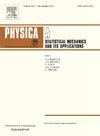自动驾驶和人类驾驶混合交通流中的汽车跟随动力学:复杂网络方法
IF 2.8
3区 物理与天体物理
Q2 PHYSICS, MULTIDISCIPLINARY
Physica A: Statistical Mechanics and its Applications
Pub Date : 2025-03-07
DOI:10.1016/j.physa.2025.130519
引用次数: 0
摘要
自动驾驶技术在提高交通运营效率和安全性方面表现出卓越的性能,为自动驾驶汽车的市场渗透率不断提高做出了贡献。本研究重点分析了混合交通流中自动驾驶汽车与人类驾驶车辆(HVs)之间的交互作用,重点研究了不同类型车辆对之间的行为差异。虽然之前的研究主要依赖于模拟和统计方法来量化自动驾驶汽车和hv之间的相互作用,但这些方法可能会忽略现实驾驶的细微差别,无法捕捉驾驶行为的动态变化。为了解决这些限制,我们利用混合交通流数据集(即Lyft Level-5 Open dataset),并应用粗粒度相空间算法来模拟CF行为的动态变化。不同车辆对之间的相互作用被表示为有向、加权的复杂网络。通过分析网络指标,提取核心子图,计算网络相似度,结果表明,汽车跟随车辆对的类型显著影响跟随行为。此外,车队中领头或跟随车辆的变化会导致跟随行为的改变,自动驾驶汽车的引入对提高交通流的安全性和效率都有积极的作用。这些基于网络的研究结果丰富了对混合交通流中不同类型车辆之间相互作用的理解,为设计考虑车辆类型异质性的混合交通流控制算法提供了坚实的基础。本文章由计算机程序翻译,如有差异,请以英文原文为准。
Car following dynamics in mixed traffic flow of autonomous and human-driven vehicles: Complex networks approach
Autonomous driving technologies have demonstrated exceptional performance in improving traffic operational efficiency and safety, contributing to the growing market penetration rate of autonomous vehicles (AVs). This study focuses on analyzing the interaction between AVs and human-driven vehicles (HVs) in mixed traffic flow, with an emphasis on the behavioral differences among various car-following (CF) vehicle pair types. While previous research has primarily relied on simulation and statistical methods to quantify the interaction between AVs and HVs, these approaches might overlook real-world driving nuances and fail to capture the dynamic changes in driving behavior. To address the limitations, we utilize a mixed traffic flow dataset (i.e., Lyft Level-5 Open Dataset), and apply a coarse-grained phase-space algorithm to model the dynamic changes in CF behavior. The interactions of different vehicle pairs are represented as directed, weighted complex networks. By analyzing network metrics, extracting core subgraphs, and calculating network similarities, the result indicates that the type of car following vehicle pair significantly influences following behavior. Moreover, changes in the leading or following vehicles within a platoon can lead to shifts in following behavior, and the introduction of AVs contributes positively to enhancing both the safety and efficiency of traffic flow. These network-based findings enrich the understanding of interactions between different vehicle types in mixed traffic flow and provide a solid foundation for designing mixed traffic flow control algorithms that account for vehicle type heterogeneity.
求助全文
通过发布文献求助,成功后即可免费获取论文全文。
去求助
来源期刊
CiteScore
7.20
自引率
9.10%
发文量
852
审稿时长
6.6 months
期刊介绍:
Physica A: Statistical Mechanics and its Applications
Recognized by the European Physical Society
Physica A publishes research in the field of statistical mechanics and its applications.
Statistical mechanics sets out to explain the behaviour of macroscopic systems by studying the statistical properties of their microscopic constituents.
Applications of the techniques of statistical mechanics are widespread, and include: applications to physical systems such as solids, liquids and gases; applications to chemical and biological systems (colloids, interfaces, complex fluids, polymers and biopolymers, cell physics); and other interdisciplinary applications to for instance biological, economical and sociological systems.

 求助内容:
求助内容: 应助结果提醒方式:
应助结果提醒方式:


